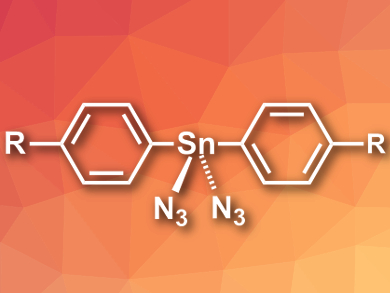Azides often are high-energy, unstable compounds that can be useful, e.g., in explosives. Binary group 14 azides of the type E(N3)n (E = Si–Sn, n = 2 or 4) are predicted to be particularly unstable and are difficult to synthesize. Their stability can, however, be improved by further ligands
Peter Portius, University of Sheffield, UK, and colleagues have synthesized the first two examples of complexes of the type Sn(N3)2(L)2 (pictured). The team reacted SnF2 with Me3Si–N3 in either pyridine (py) or 4-picoline at room temperature. The solution was then concentrated and cooled until the product crystallized. The resulting compounds were characterized using X-ray crystallography, IR and NMR spectroscopy, and differential scanning calorimetry.
The team found that the pyridine and 4-picoline derivatives have melting points of 60 °C and 100 °C, respectively, and undergo strongly exothermic decomposition at temperatures above 172 °C and 180 °C. At room temperature, the complexes are stable and not sensitive to friction or impact. In the presence of MeCN, the pyridine ligands of Sn(N3)2(py)2 dissociate, which allowed the team to synthesize Sn(N3)2 in a safe and efficient manner. Sn(N3)2 is an explosive compound resembling lead(II) azide, but with a higher sensitivity.
- Labile Low-Valent Tin Azides: Syntheses, Structural Characterization, and Thermal Properties,
Rory Campbell, Sumit Konar, Steven Hunter, Colin Pulham, Peter Portius,
Inorg. Chem. 2017.
https://doi.org/10.1021/acs.inorgchem.7b02621




